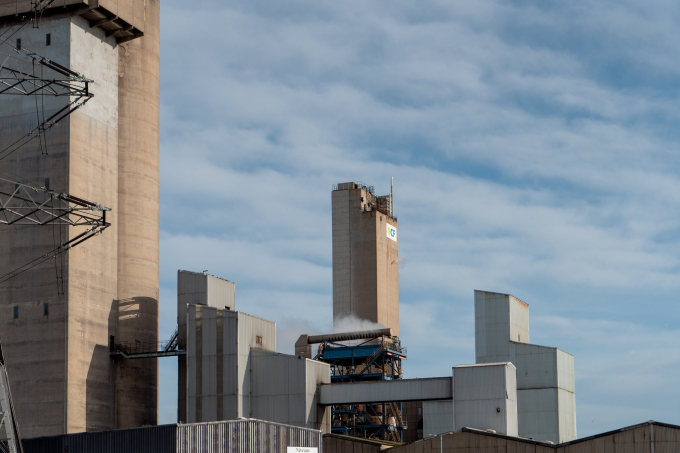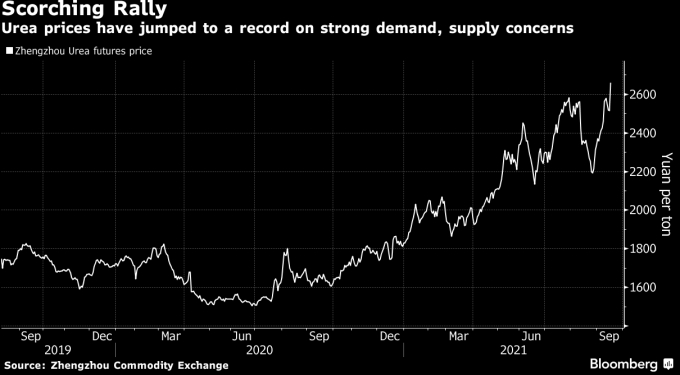November 28, 2025 | 01:27 GMT +7
November 28, 2025 | 01:27 GMT +7
Hotline: 0913.378.918
November 28, 2025 | 01:27 GMT +7
Hotline: 0913.378.918

CF Fertiliser’s plant in Billingham, England. The company’s parent, CF Industries, said it would halt operations at two plants in Britain because of high prices of natural gas. Photo: New York Times
But with prices for some synthetic nutrients at their highest levels since the financial crisis, it could mean weaker harvests and bigger grocery bills next year, just as the world’s supply chains start to recover from the pandemic.
A perfect storm of events -- from extreme weather and plant shutdowns to new government sanctions -- has hit the chemical fertilizer market this year, slamming farmers already buckling under the strain of rising costs to produce food. Prices for urea, a popular nitrogen-based fertilizer, skyrocketed earlier this month to the highest since 2012 in New Orleans, the U.S.’s major fertilizer trading hub. A common phosphate fertilizer known as DAP is the most expensive in that market since 2008, Bloomberg data show.
“As fertilizer prices continue to rise, farmers will either cut application rates, cut fertilizer entirely in hopes for lower future pricing, or cut other farm products to account for the bigger expected spend,” said Alexis Maxwell, an analyst at Green Markets, a business owned by Bloomberg. Some are holding out before buying for the next growing season in hopes costs come down -- a risk, she said, since prices could continue to rise.
Farmers growing the commodity-grade corn, soy and other grains that fuel both livestock and packaged-food factories are already spending more than normal on seeds, labor, transportation and equipment. That’s helped contribute to sharp food inflation over the past year. A United Nations measure of global food prices is near the highest in a decade, a problem the fertilizer spike could exacerbate.
“Fertilizer cost is one of the biggest drivers behind global food inflation now as prices for all three groups of nutrients -- potash, phosphate and nitrogen -- are at levels not seen for about a decade,” Elena Sakhnova, a VTB Capital analyst in Moscow, said in an interview.
A confluence of events are behind the rising prices. Back-to-back late summer storms on the U.S. Gulf Coast prevented product from moving in and out and temporarily shuttered plants in the region, including the largest nitrogen complex in the world, owned by CF Industries Holdings Inc. The company was then forced to shut two U.K. plants due to Europe’s record rally in natural gas, the primary feedstock for much of the nitrogen produced globally. On Friday, Yara International ASA said the high natural gas prices will force it to curtail around 40% of its European production capacity for ammonia, used to make fertilizer.
The logistics companies that transport fertilizer are also facing labor shortages and price increases, adding to costs.

As fertilizer prices continue to rise, farmers will either cut application rates, cut fertilizer entirely in hopes for lower future pricing, or cut other farm products to account for the bigger expected spend.
“It sure has made things tremendously more difficult to work with,” said Bill Stringfellow, who co-runs a small operation called Quest Products that helps bring new products to the market, including pesticides and fertilizer products. Freight is about 15% of the cost of buying product for their business, he said, calling it “an absolute nightmare.”
Government action is also at play. Earlier this year, the U.S. and Europe put sanctions on Belaruskali OAO, a major potash producer and one of Belarus’s largest state-owned enterprises, in response to a journalist arrest on a Ryanair flight in May. In China, Yunnan province ordered production cuts across several industries, including fertilizers, as part of measures to curb energy consumption and emissions.
The National Development and Reform Commission has vowed to crack down on urea hoarding and price gouging to maintain market stability, but prices have still been soaring: Urea futures on the Zhengzhou Commodity Exchange have powered to a fresh record amid high prices for coal -- the primary feedstock for nitrogen fertilizers in China -- and concerns over tight supplies.
Silvesio de Oliveira, a 51-year-old soybean and corn farmer in Tapurah -- at the heart of Brazil’s soybean belt -- was fortunate enough to get ahead of the latest price rise. Last November, he bought 100% of the fertilizer needed for both crops.
“We’ve been noticing this fertilizer inflation coming,” he said. He got out ahead because he voraciously reads commodities news, he said. “There’s a bit of luck, but it is mostly information.”
If farmers cut back how much fertilizer they use, among the most impacted could be corn, one of the highest yielding crops but also an expensive one to raise. Fertilizer accounts for about 20% of that expense, said Maxwell, the Green Markets analyst. Other farmers might shift to cheaper crops that require lower inputs, such as soybeans, lentils and peas, said Iowa corn and soybean farmer Ben Riensche.
Smaller corn crops could mean elevated feed costs for dairy and other animal farmers, ultimately translating to higher prices for consumers buying meat like beef and chicken. Corn -- its high-fructose syrup, that is -- is also a major ingredient in sodas, juice and other processed food consumed by many households.
“We’re anticipating this will impact the acreage battle next year,” said StoneX chief commodities economist Arlan Suderman. “We are looking for lower corn acres next year as a result.” Suderman estimates acres of U.S. corn at 91 million, down from 93.5 million this year.
Plants, like people, need a combination of nutrients to survive, and multiple types of fertilizer provide different inputs. Nitrogen pretty much has to be applied every year, so farmers are unlikely to cut the amount they buy and apply to fields, Maxwell said.
As a result, farmers are more likely to cut back on phosphate and potash, instead relying on the nutrients they hope are already in the soil. But some farmers might even cut nitrogen application if the prices continue to rise, said Jerome Lensing, an independent crop adjuster at insurer Rain and Hail -- and that could be a problem.
“With the price of nitrogen going up,” he said, “I hope guys don’t back off so much that come next fall, when they’re out harvesting, they’re saying, ‘how come I’m not getting the corn I thought I should be?’”
(Bloomberg)

(VAN) A new study reveals how the simultaneous effects of ocean acidification, salinity and loss of oxygen are making the world more fragile.

(VAN) Hopes are growing that the creation of the first 3D turkey gut model could be a turning point in the battle against the virulent blackhead disease.

(VAN) Tyson, America’s biggest meat supplier, plans to shutter one of its largest beef processing plants as the industry continues to struggle with low cattle supplies and political pressure from Washington.

(VAN) New FAO study shows how digital solutions are empowering farmers and fishers to prevent losses and build resilient agrifood systems.

(VAN) Brazil's COP30 presidency pushed through a compromise climate deal on Saturday that would boost finance for poor nations coping with global warming but that omitted any mention of the fossil fuels driving it.

(VAN) Poultry farmers in the UK have been warned that they could face one of the worst winters yet for bird flu.

(VAN) Prices of main-crop paddy have risen sharply, with jasmine rice hitting 16,100 baht per tonne — the highest level in years.